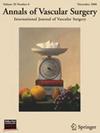Inflammatory Biomarker-Based Risk Prediction Model for Endovascular Reconstruction in Acute Lower Limb Ischemia: A Multicenter Development and Validation Study
IF 1.6
4区 医学
Q3 PERIPHERAL VASCULAR DISEASE
引用次数: 0
Abstract
Background
Inflammatory markers are associated with poor prognosis of peripheral vascular diseases. We aim to determine the relationship between inflammatory markers and the prognosis of acute lower limb ischemic disease and to construct and verify a prognostic model based on inflammatory indicators.
Methods
We evaluated 295 patients with a diagnosis of acute lower limb ischemia (ALI) from multiple centers between 2020 and 2023. The association between baseline disease characteristics with length of stay and half-year cutoff results were determined using Statistical Product and Service Solutions software and R language, respectively. We identified predictive factors and built a nomogram to predict 30-day amputation rate in patients with ALI after endovascular surgery.
Results
In the training cohort, 34 patients underwent amputation within 30-day after endovascular surgery. Atrial fibrillation, diabetes, Rutherford grade IIb, higher neutrophil-to-lymphocyte ratio (NLR), higher platelet-to-lymphocyte ratio (PLR), lower hemoglobin, higher low-density lipoprotein (LDL), and higher triglyceride (TG were independently associated with 30-day amputation. Preoperative NLR, PLR, and LDL presented a good discriminative ability (NLR: area under the receiver operating characteristic curve [AUC] = 0.927; PLR: AUC = 0.839; LDL: AUC = 0.724). Five independent risk factors, such as diabetes, Rutherford grade, NLR, PLR, and LDL, were screened from the results of the multivariate logistic analysis of the training cohort and included in the nomogram. The calibration curve also proved that the nomogram predicted outcomes were close to the ideal curve and the decision curve analysis curve showed that all patients could benefit with threshold probability within 0–95%.
Conclusion
A nomogram for postoperative endovascular reconstruction of ALI was constructed with good predictive performance, which can be used as an auxiliary diagnosis of the potential risk factors and assist surgeon in making a personalized diagnosis and treatment for patients.
基于炎症生物标志物的急性肢体缺血血管内重建风险预测模型:一项多中心开发和验证研究。
背景:炎症标志物与周围血管疾病的不良预后相关。我们旨在确定炎症标志物与急性下肢缺血性疾病预后的关系,构建并验证基于炎症指标的预后模型。方法:我们评估了2020年至2023年间多个中心诊断为急性下肢缺血(ALI)的295例患者。分别使用SPSS软件和R语言确定基线疾病特征与住院时间和半年截止结果之间的关系。我们确定了预测因素,并建立了一个图来预测血管内手术后ALI患者30天的截肢率。结果:在训练队列中,34例患者在血管内手术后30天内截肢。房颤、糖尿病、卢瑟福ⅱib级、较高的中性粒细胞与淋巴细胞比值(NLR)、较高的血小板与淋巴细胞比值(PLR)、较低的血红蛋白(Hb)、较高的低密度脂蛋白(LDL)和较高的甘油三酯(TG)与30天截肢独立相关。术前NLR、PLR、LDL具有较好的判别能力(NLR: AUC=0.927;PLR: AUC = 0.839;低密度脂蛋白:AUC = 0.724)。从训练队列的多因素logistic分析结果中筛选出糖尿病、卢瑟福分级、NLR、PLR、LDL 5个独立危险因素,并纳入nomogram。标定曲线也证明nomogram预测结果接近于理想曲线,决策曲线分析(decision curve analysis, DCA)曲线显示所有患者均能获益,阈值概率在0-95%之间。结论:构建了ALI术后血管内重建的影像学图,具有较好的预测性能,可作为潜在危险因素的辅助诊断,辅助外科医生对患者进行个性化诊断和治疗。
本文章由计算机程序翻译,如有差异,请以英文原文为准。
求助全文
约1分钟内获得全文
求助全文
来源期刊
CiteScore
3.00
自引率
13.30%
发文量
603
审稿时长
50 days
期刊介绍:
Annals of Vascular Surgery, published eight times a year, invites original manuscripts reporting clinical and experimental work in vascular surgery for peer review. Articles may be submitted for the following sections of the journal:
Clinical Research (reports of clinical series, new drug or medical device trials)
Basic Science Research (new investigations, experimental work)
Case Reports (reports on a limited series of patients)
General Reviews (scholarly review of the existing literature on a relevant topic)
Developments in Endovascular and Endoscopic Surgery
Selected Techniques (technical maneuvers)
Historical Notes (interesting vignettes from the early days of vascular surgery)
Editorials/Correspondence

 求助内容:
求助内容: 应助结果提醒方式:
应助结果提醒方式:


